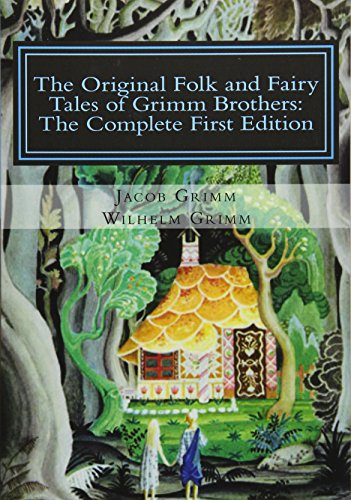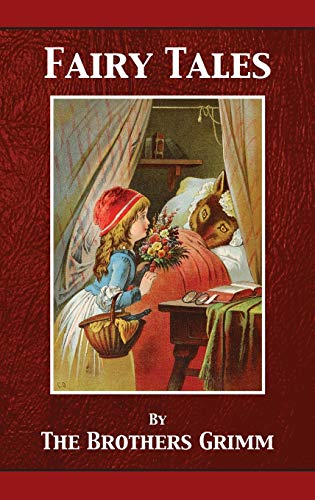-
Grimm's Fairy Tales
Jacob Grimm, Wilhelm Grimm
language (, March 24, 2011)These classic fairy tales have left an indelible mark on Western culture, a testament to the brilliance and skill of Jacob and Wilhelm Grimm. Z
Z
-
The Original Folk and Fairy Tales of Grimm Brothers: The Complete First Edition
Jacob Grimm, Wilhelm Grimm
Paperback (CreateSpace Independent Publishing Platform, Nov. 29, 2014)• The complete text of all 211 fairy tales collected by the Brothers Grimm. • This book publication is unique which includes exclusive Introduction. • This edition also includes detailed Biography. • This edition has been corrected for spelling and grammatical errors. Full of magic and trickery, Grimm's Fairy Tales have delighted generations with such timeless classics as Cinderella, Red Riding Hood, Hansel and Gretel, Snow White, and Rapunzel. The Complete Fairy Tales Every fairy tales collected by the Brothers Grimm are included—that's over 200 tales. Popular favorites include: • Cinderella • Beauty and the Beast • Little Red-Cap (Little Red Riding Hood) • Briar Rose (Sleeping Beauty) • Hansel and Grethel • Snow White • Rapunzel • Rumpelstiltskin • and hundreds more!
-
Grimms' Fairy Tales: Dual Language:
Jacob Grimm, Wilhelm Grimm
Paperback (JiaHu Books, May 31, 2015)Kinder- und Hausmärchen is a collection of German fairy tales first published in 1812 by the Grimm brothers, Jacob and Wilhelm. The tales have formed the basis for children's tales in the Western world ever since.This volume presents several of the most popular tales, including Cinderella and Snow White, in the original German side by side with classic English translations. P
P
-
Grimm's Fairy Tales
Wilhelm Grimm, Jacob Grimm, Nicki White, Lark Audiobooks
Audiobook (Lark Audiobooks, April 11, 2016)A selection of classic children's stories by the Brothers Grimm.
-
Grimm's Fairy Tales
Jacob Grimm, Wilhelm Grimm, Edgar Taylor
Paperback (Independently published, Dec. 3, 2019)This work has been selected by scholars as being culturally important, and is part of the knowledge base of civilization as we know it.
-
Grimms' Fairy Tales
Wilhelm Grimm, Jacob Grimm
Hardcover (12th Media Services, Oct. 29, 2019)Grimms' Fairy Tales is a collection of fairy tales by the Grimm brothers or "Brothers Grimm", Jakob and Wilhelm, and was first published in 1812.This non-illustrated edition contains 67 stories including favorites such as Little Red Riding Hood, The Frog-Prince, Rapunzel, Hansel And Gretel, Rumpelstiltskin, The Elves and The Shoemaker, and Snow-White. Z
Z
-
Grimms' Fairy Tales
Jacob Grimm, Wilhelm Grimm, SBP Editors
eBook (Samaira Book Publishers, May 11, 2017)For most children, reading the fairy tales of the Brothers Grimm is an essential experience when growing up. Grimm's Fairy Tales collects fifty-five of the best-known fairy and folk tales set down by the Brothers Grimm, including 'Sleeping Beauty,' 'Snow White and the Seven Dwarfs,' 'Little Red Riding Hood,' 'Hansel and Gretel,' 'The Frog-Prince,' and 'Rumpelstiltskin'. The Brothers Grimm rediscovered a host of fairy tales, telling of princes and princesses in their castles, witches in their towers and forests, of giants and dwarfs, of fabulous animals and dark deeds.ABOUT THE AUTHOR:The Brothers Grimm, Jacob (1785-1863) and Wilhelm (1786-1859), were born in Hanau, near Frankfurt, in the German state of Hesse. Throughout their lives they remained close friends, and both studied law at Marburg University. Jacob was a pioneer in the study of German philology, and although Wilhelm’s work was hampered by poor health the brothers collaborated in the creation of a German dictionary, not completed until a century after their deaths. But they were best (and universally) known for the collection of over two hundred folk tales they made from oral sources and published in two volumes of ‘Nursery and Household Tales’ in 1812 and 1814. Although their intention was to preserve such material as part of German cultural and literary history, and their collection was first published with scholarly notes and no illustration, the tales soon came into the possession of young readers. This was in part due to Edgar Taylor, who made the first English translation in 1823, selecting about fifty stories ‘with the amusement of some young friends principally in view.’ They have been an essential ingredient of children’s reading ever since.
-
Grimms' Fairy Tales
The Brothers Grimm, Rachel Lay, Edgar Taylor, Marian Edwardes
eBook (, Aug. 9, 2014)▪ This book includes 10 unique illustrations that are relevant to its content.Children's and Household Tales (German: Kinder- und Hausmärchen) is a collection of German fairy tales first published in 1812 by Jacob and Wilhelm Grimm, the Brothers Grimm. In the English-speaking world, the collection is commonly known today as Grimms' Fairy Tales (German: Grimms Märchen). On December 20, 1812, they published the first volume of the first edition, containing 86 stories; the second volume of 70 stories followed in 1814. For the second edition, two volumes were issued in 1819 and a third in 1822, totalling 170 tales. The third edition appeared in 1837; fourth edition, 1840; fifth edition, 1843; sixth edition, 1850; seventh edition, 1857. Stories were added, and also subtracted, from one edition to the next, until the seventh held 211 tales. All editions were extensively illustrated, first by Philipp Grot Johann and, after his death in 1892, by Robert Leinweber.The first volumes were much criticized because, although they were called "Children's Tales", they were not regarded as suitable for children, both for the scholarly information included and the subject matter. Many changes through the editions – such as turning the wicked mother of the first edition in Snow White and Hansel and Gretel to a stepmother, were probably made with an eye to such suitability. They removed sexual references—such as Rapunzel's innocently asking why her dress was getting tight around her belly, and thus naïvely revealing her pregnancy and the prince's visits to her stepmother—but, in many respects, violence, particularly when punishing villains, was increased.In 1825 the Brothers published their Kleine Ausgabe or "small edition," a selection of 50 tales designed for child readers. This children's version went through ten editions between 1825 and 1858.The influence of these books was widespread. W. H. Auden praised the collection, during World War II, as one of the founding works of Western culture. The tales themselves have been put to many uses. The Nazis praised them as folkish tales showing children with sound racial instincts seeking racially pure marriage partners, and so strongly that the Allied forces warned against them; for instance, Cinderella with the heroine as racially pure, the stepmother as an alien, and the prince with an unspoiled instinct being able to distinguish. Writers who have written about the Holocaust have combined the tales with their memoirs, as Jane Yolen in her Briar Rose.The work of the Brothers Grimm influenced other collectors, both inspiring them to collect tales and leading them to similarly believe, in a spirit of romantic nationalism, that the fairy tales of a country were particularly representative of it, to the neglect of cross-cultural influence. Among those influenced were the Russian Alexander Afanasyev, the Norwegians Peter Christen Asbjørnsen and Jørgen Moe, the English Joseph Jacobs, and Jeremiah Curtin, an American who collected Irish tales. There was not always a pleased reaction to their collection. Joseph Jacobs was in part inspired by his complaint that English children did not read English fairy tales; in his own words, "What Perrault began, the Grimms completed".Three individual works of Wilhelm Grimm include Altdänische Heldenlieder, Balladen und Märchen ('Old Danish Heroic Lays, Ballads, and Folktales') in 1811, Über deutsche Runen ('On German Runes') in 1821, and Die deutsche Heldensage ('The German Heroic Legend') in 1829.
-
Grimms' Fairy Tales
Jacob Grimm
language (, June 6, 2020)A certain king had a beautiful garden, and in the garden stood a tree which bore golden apples. These apples were always counted, and about the time when they began to grow ripe it was found that every night one of them was gone. The king became very angry at this, and ordered the gardener to keep watch all night under the tree. The gardener set his eldest son to watch; but about twelve o'clock he fell asleep, and in the morning another of the apples was missing. Then the second son was ordered to watch; and at midnight he too fell asleep, and in the morning another apple was gone. Then the third son offered to keep watch; but the gardener at first would not let him, for fear some harm should come to him: however, at last he consented, and the young man laid himself under the tree to watch. As the clock struck twelve he heard a rustling noise in the air, and a bird came flying that was of pure gold; and as it was snapping at one of the apples with its beak, the gardener's son jumped up and shot an arrow at it. But the arrow did the bird no harm; only it dropped a golden feather from its tail, and then flew away. The golden feather was brought to the king in the morning, and all the council was called together. Everyone agreed that it was worth more than all the wealth of the kingdom: but the king said, 'One feather is of no use to me, I must have the whole bird.
-
Grimms' Fairy Tales
Jacob and Wilhelm Grimm
Paperback (Dover Publications, June 12, 2019)Like Sleeping Beauty awakening from her 100-year slumber, these childhood favorites arise fresh and blooming every time they're read. This new compilation of some of the world's greatest fairy tales abounds in timeless stories of the struggle of good against evil, bravery in the face of overwhelming danger, and virtue rewarded with everlasting love. Told to Jacob and Wilhelm Grimm almost two centuries ago by European storytellers, the tales possess all of the most engaging elements of folklore — from magic spells and enchanted frogs to a colorful cast of noble princes, lovely maidens, giants, witches, and other fantastic characters. These forty-five unabridged stories, selected from the more than 200 collected by the Brothers Grimm, include such unforgettable classics as "Snow White," "The Elves and the Shoemaker," "The Brave Little Tailor," "The Golden Goose," "Hansel and Gretel," "Little Red Riding Hood," "Rumpelstiltskin," "Rapunzel," and "Tom Thumb." Z
Z
-
Grimm's Fairy Tales
Jacob Grimm, Wilhelm Grimm
eBook (, Nov. 9, 2014)Children's and Household Tales is a collection of German fairy tales published in 1812 by the Grimm brothers, Jacob and Wilhelm. The collection is commonly known in the Anglosphere as Grimm's Fairy Tales. This edition has been formatted for your Kindle, with an active table of contents. It also contains beautiful illustrations of the various tales. Furthermore, this work is annotated, with additional information about the book and its authors, including an overview, influence, background, and themes
-
Grimm's Fairy Tales
Jacob Grimm, Wilhelm Grimm
eBook (, Nov. 9, 2014)Children's and Household Tales is a collection of German fairy tales published in 1812 by the Grimm brothers, Jacob and Wilhelm. The collection is commonly known in the Anglosphere as Grimm's Fairy Tales. This edition has been formatted for your Kindle, with an active table of contents. It also contains beautiful illustrations of the various tales. Furthermore, this work is annotated, with additional information about the book and its authors, including an overview, influence, background, and themes Z
Z